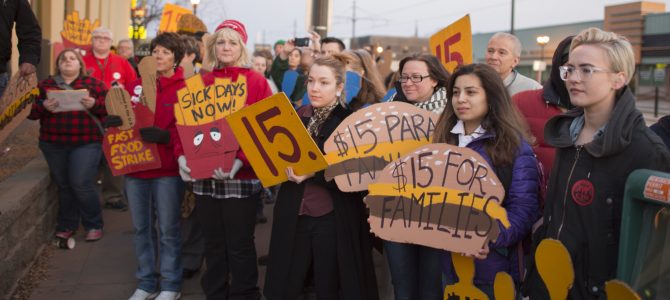
Harvard Business School recently released a working paper titled “Survival of the Fittest: The Impact of the Minimum Wage on Firm Exit,” discussing the effects of minimum wage policies on companies’ survival. For those with any shred of economic understanding, the results were predictably dismal.
The paper focused specifically upon the restaurant industry in San Francisco, using data from the review platform Yelp to track the activity and performance of individual restaurants. Researchers Dara Lee Luca and Michael Luca discovered that a $1 increase in the minimum wage leads to approximately a 4 to 10 percent increase in the likelihood of any given restaurant exiting the industry entirely. In economic terms, minimum wage hikes quicken a restaurant’s “shutdown” point.
Luca and Luca found this effect to be more pronounced among the restaurants with lower ratings while essentially nonexistent among five-star restaurants. A $1 increase in the minimum wage increased the likelihood of a 3.5-star exiting by roughly 14 percent, while having zero effects on the restaurants with five-star ratings. In other words, minimum wage hikes disproportionately affect the restaurants that are already struggling in popularity.
Counterproductive Advocacy for Minimum Wage Hikes
Why is this paper stunningly relevant? In an era where liberal-minded folks see increasing the minimum wage as a key way to equalize economic outcomes, studies such as this undercut the ignorant economics those on the Left espouse. Basic economics tell us that increasing the minimum wage will hurt not only firms by increasing their operational costs but also the very workers they presumably fire in the process to keep those operational costs down.
Luca and Luca’s paper offers an alternative approach to examining the effects of minimum wage hikes. A large portion of research related to minimum wage hikes examines the impact on unemployment. This particular paper shows that not all firms adjust to hikes by merely raising the prices of the goods and services they provide or firing a fraction of their workers. Some firms shut down altogether, taking their job opportunities with them.
The #Fightfor15 interest group, among others, is therefore working primarily against its own very interests. The group touts itself as seeking racial and economic justice through promoting a nationwide $15 minimum wage. Since almost 40 percent of minimum-wage workers are either black or Hispanic, Fightfor15 has joined forces with Black Lives Matter. However, what Fightfor15 and BLM do not realize is that their missions undercut each other, at least regarding expected economic outcomes.
The theory behind Fightfor15 is to give the people who “do the real work” their just pay, and end higher salaries for companies’ higher-ups. While this measure sounds reasonable to the Left, it’s incredibly ignorant of how pay processes ultimately work. If government forces companies to pay workers a certain amount that exceeds traditional operational costs, they will not simply shave managers’ pay. Instead, they will find ways to thin their operational costs, usually by reducing the hours of certain workers or directly firing others. Or, as indicated in the study published by Luca and Luca, some smaller, less popular firms will simply shut down.
Whom Do Minimum Wage Hikes Most Affect?
When we discuss hikes in minimum wage, we must consider exactly whom such policies affect. California has the largest restaurant industry in the country, clocking in at 4 percent of the United States’ total gross domestic product, and one of the highest proportions of non-white restaurant workers. Indeed, Latinos make up more than 50 percent of California’s restaurant workforce alone. Thus, it’s not far-fetched but instead entirely accurate to recognize that groups such as Fightfor15 actively work against their own interests of “racial and economic justice.”
Economists have found minimum wage hikes to be unhelpful in reducing inequality and followed by more low-income workers being laid off, a great number of whom are people of color. The first of a series of scheduled minimum wage hikes in Seattle in 2015 resulted in a 1 percent drop in the employment rate of Seattle’s low-wage workers and preceded the worst job decline for the city since the 2008-09 recession.
According to a 2014 report, only 17 percent of Seattle workers previously making under $15 per hour before the hike were white. The rest were Asian (20 percent), Black (28 percent), and Hispanic (22 percent). Undoubtedly, these folks were disproportionately hurt by the reduction in employment that followed the hikes.
While “racial and economic justice” through forced minimum wage hikes sounds appealing, it just doesn’t work the way its supporters suppose. In fact, quite the opposite. Slapping a $15 minimum wage requirement on a large corporation might “feel good” to angry workers, but those very workers are ultimately the ones who will pay the price.
No one ever said class warfare rhetoric made economic sense. San Francisco will soon relearn that this summer when it raises its minimum wage again.









